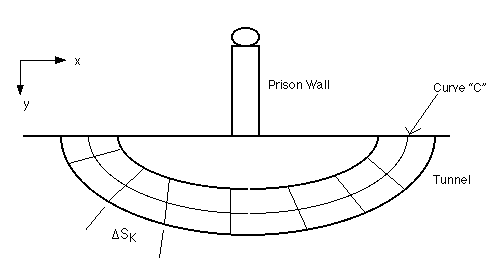
Imagine an island populated exclusively with rabbits and foxes
Let R(t), a function of time, be a continuous
representation of the rabbit population
Let F(t), also a function of time, represent
the fox population.
Given four constants of proportionality a,b,c,&d, we can create a model
of how the populations change.
The Rabbit population will increase proportionally to the number of Rabbits
already on the island, the more Rabbits, the more reproduction.
The Rabbit population will also decrease proportionally to the number of
encounters Rabbits have with Foxes, which we can represent by the product
of the number of Foxes and rabbits, R*F.
So, the rate of change of the Rabbits is dR/dt = aR - bRF
Similarly, the Fox population will decrease prportionally to the number of
Foxes - the more Foxes the less rabbits (i.e. food) per Fox.
The Fox population will increase proportionally to the number of encounters
of Foxes with Rabbits, represented again by R*F
The rate of change of the Foxes is then dF/dt = -cF + dRF
This is a system of 1st order differential equations, which can be analyzed numerically using techniques we'll learn later in the course. The resulting solution is an oscillatory one, i.e., like populations.
A Partial Differential equation is one that involves partial derivatives.
An example would be the case of the temperature T, of a straight rod. The
temperature is a function of both time and position. These dependancies
are related in the heat equation:

A graph shows how the series converges towards the square wave.

A line integral is summing up (Integrating) a scalar quantity along a given line or curve.
Imagine an inmate attempting to escape from prison. He has a tunnel plan all made out, but he'd like to know how much mass of dirt he's going to have to remove.

Suppose the density of the dirt is a function of depth - D(y).
The cross-sectional area of the tunnel is A.
To find out how much mass of dirt he has, the prisoner breaks up the tunnel plan into small sections. By approximating D in each section to be the average value for the section, he can add up the pieces.

An Example for a circular path:

x(t) = R cos t
y(t) = R sin t
0<=t<=2*
Define a "velocity" vector for a path as:
v = dr/dt = dx/dt i + dy/dt j
+ dz/dt k.
Now, back to the standard line integral form:

If we take a small segment of the path we can see that, being nearly linear, it's differential length, ds, is equal to the speed, ||v||, times the differential time in traversing that length, dt. That is, ds = ||v|| dt

So, the integral is now:


